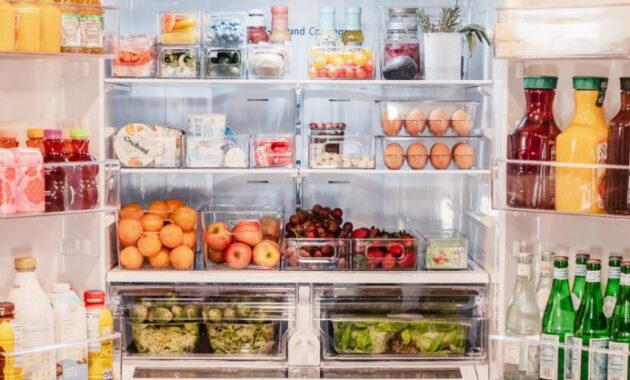Organize the refrigerator: The way to a tidy refrigerator compartment
The yoghurt next to the jam and the cucumber next to the cold cuts – who wants to organize the groceries in the fridge after a strenuous shopping trip? Nevertheless, order in the kitchen is the be-all and end-all. You benefit from systematic order in many ways, especially when it comes to refrigeration. For one thing, you’ll find the ingredients you’re looking for more quickly. On the other hand, by storing the various supplies correctly, you extend their shelf life, avoid forgotten products in the depths of your refrigerator compartments and also contribute to the energy efficiency of your refrigerator.
But how should you best organize the refrigerator compartment? Where do dairy products go? Where is the best place to store sauces and leftovers? What belongs in the door compartments and do all vegetables really go in the vegetable compartment? In this blog article we will introduce you to the art of refrigerator organization and explain step-by-step how you can organize your refrigerator and reduce your personal food waste and use storage space efficiently.
Contents
- Food waste, shelf life & energy efficiency – this is why you should organize your fridge
- Organize the refrigerator: The zones of your refrigerator from the vegetable compartment to the refrigerator door
- The vegetable compartment with the best air circulation
- Drawer above the vegetable compartment for perishable products
- Yoghurt, cheese & quark – middle compartments for dairy products
- Sauces, Jams & Preserves – Organize top compartments in the refrigerator
- Compartments in the refrigerator door for drinks & sauces
- Organizing the Fridge: The Role of the Freezer Compartment
- Step-by-step instructions: Efficient storage
- Food storage containers, boxes and compartments – proven systems and tools for organizing the refrigerator
- Organize the refrigerator: This doesn’t belong in the refrigerator
- Organize the refrigerator & use storage space: Conclusion
Food waste, shelf life & energy efficiency – this is why you should organize your fridge
- Minimize food waste: Food is often forgotten in an unsorted refrigerator and when it is found again, it is often past its best before or expiry date and is no longer edible. When you organize your refrigerator, you always stay on top of things.
- Keep food fresher for longer: Perishable supplies such as dairy products, leftovers and opened sauces and jars must be kept cool. However, the correct storage temperature varies from food to food. By taking the cooling zones into account, you can store your supplies in the right place in the future and thus extend their shelf life.
- Save energy: Constantly opening and closing the refrigerator door costs energy. Every time you open it, heat is let in and the refrigerator then has to cool down again. By knowing exactly where the yoghurt, jam or sauce you are looking for is, the door doesn’t stay open for as long and you save electricity.
Organize the refrigerator: The zones of your refrigerator from the vegetable compartment to the refrigerator door
Your refrigerator is much more than just a cool place to store your perishable supplies. It is a complex system that, when filled correctly, can not only keep food as fresh as possible, but also ensure its own energy efficiency. In order to properly organize the refrigerator, it is important to know that it has different cooling zones that are suitable for some foods more and less for others.
The vegetable compartment with the best air circulation
The vegetable compartment is located at the bottom of the cupboard and is temperature-controlled so that certain types of fruit and vegetables can be easily stored there. The special feature of the vegetable compartment is the increased humidity. This is needed to keep lettuce, cucumbers, tomatoes etc. fresher for longer.
Tip: A refrigerator mat in the vegetable compartment allows for better air circulation and ensures that cucumbers, lettuce, etc. last longer.
Drawer above the vegetable compartment for perishable products
This is the coolest zone of the refrigerator at two to three degrees. When organizing your refrigerator, be sure to put perishable products in this shelf. These include, for example, meat, sausage and fish. Cold cuts are also best served here.
Yoghurt, cheese & quark – middle compartments for dairy products
The middle refrigerator compartments have a temperature of three to five degrees. This zone is best suited for dairy products such as butter, cheese, yogurt and cottage cheese. If you don’t have space in your refrigerator door, you can also store milk in the middle compartment.
Sauces, Jams & Preserves – Organize top compartments in the refrigerator
The warmest zone is at the top of the refrigerator. Food that does not need to be cooled as much should therefore be stored here. These include, for example, opened jams and canned goods and prepared meals. Sauces that no longer fit in the door compartment can also be stored here.
Compartments in the refrigerator door for drinks & sauces
The door compartments are exposed to the greatest temperature fluctuations and are therefore suitable for less temperature-sensitive products such as drinks, sauces and butter. You can also easily store milk in the door compartment.
Organizing the Fridge: The Role of the Freezer Compartment
There is space in the freezer for all those products that are either already frozen or those that you don’t need as often. You can also store leftover food in airtight food storage containers in the freezer and thus extend its shelf life enormously. This is an easy way to prevent food waste. However, find out in advance which foods can and cannot be frozen.
Step-by-step instructions: Efficient storage
1. Keep or throw away? Clear out and sort out expired items
The first step in organizing the refrigerator is to completely empty it and take an inventory. Which foods are still used? Are there any forgotten food leftovers or supplies that are well past their best-before date or expiration date and are spoiled? Think about what food you want to store. You should clear out everything that you will no longer eat. In order to prevent unpleasant smells and always keep track of the contents of the refrigerator, it is strongly recommended that you empty the refrigerator completely.
Note: The best-before date is not necessarily the expiry date. Food – especially dairy products such as yoghurt – can often be consumed well beyond the stated date.
2. Defrost the refrigerator
After clearing out, it is recommended to defrost the entire refrigerator including the freezer compartment or freezer at least once a year. Occasionally ice forms on the back wall, which not only takes up storage space but also increases energy consumption. With defrosted cooling you can create the best conditions for a well-organized refrigerator.
3. Clean
The foundation of an organized refrigerator is cleanliness. So before you start sorting the individual foods, you should first thoroughly clean the refrigerator compartment with all shelves. To do this, simply take a cleaning cloth and wipe all shelves, compartments and side and back walls with an appropriate cleaning agent such as a kitchen or refrigerator cleaner or alternatively with dishwashing liquid. Don’t forget to clean the seals and drain channels too. Dirt tends to accumulate in these areas and unpleasant smells arise. You should carry out this procedure occasionally to maintain hygiene in the refrigerator compartment and to avoid heavy contamination.
4. Label, tidy & sort
Instead of simply putting new, shelf-stable foods back in the refrigerator, they should be sorted first. With appropriate storage boxes and shelves, you can, for example, separate fruit from vegetables or cheese from cold cuts. Don’t forget to label your storage boxes. This will help you find the products you are looking for more quickly at a later date. Once you have labeled all of the storage containers and packages, you can place them in the appropriate zone of your refrigerator compartment.
Food storage containers, boxes and compartments – proven systems and tools for organizing the refrigerator
Storage boxes
Storage containers such as storage boxes are particularly suitable for food that is not packaged in jars or other packages. For example, fruits and vegetables can be easily separated from each other. But jars such as jam, opened canned goods such as dried tomatoes or pickled onions can also be combined in one storage container. Airtight food storage containers that can be closed are suitable for cold cuts and cheese. This not only avoids an unpleasant smell in the refrigerator caused by, for example, opened cheese, but also prevents the food from drying out.
Organize the refrigerator with flexible shelves
Depending on the refrigerator manufacturer and model, there are already some flexible shelves available for organizing the refrigerator. Many manufacturers equip their models with egg holders or other holders in the door compartment as standard. Additional areas can be created especially for sauces or drinks using appropriate devices.
Organize the refrigerator: This doesn’t belong in the refrigerator
Not all fruits and vegetables need to be stored in a cool place. In fact, some foods are not suitable for refrigeration and will spoil more quickly if they are stored there. These include, for example:
- potatoes
- Onions
- aubergine
- tomatoes
- Cucumber
- paprika
- avocado
- Berry
- Citrus fruits
Organize the refrigerator & use storage space: Conclusion
A tidy and well-organized refrigerator not only saves you time and stress, but also contributes significantly to your energy consumption in the kitchen. So if you want to save electricity in the kitchen, you should take time to clean your refrigerator every now and then. To do this, start by carefully sorting out expired food or spoiled food that you definitely no longer eat. Then it’s time to clean it with a cleaning agent or dishwashing liquid. In this context, it is also advisable to defrost the freezer and tidy it up there too. After you have categorized and labeled your food, you can put it in the refrigerator. Please note the different cooling zones in order to achieve the maximum shelf life of each individual food and avoid food waste. Also make sure that not all fruits and vegetables actually belong in the refrigerator and need to be stored elsewhere. For example potatoes, avocado or citrus fruits. We wish you much success organizing your refrigerator!




